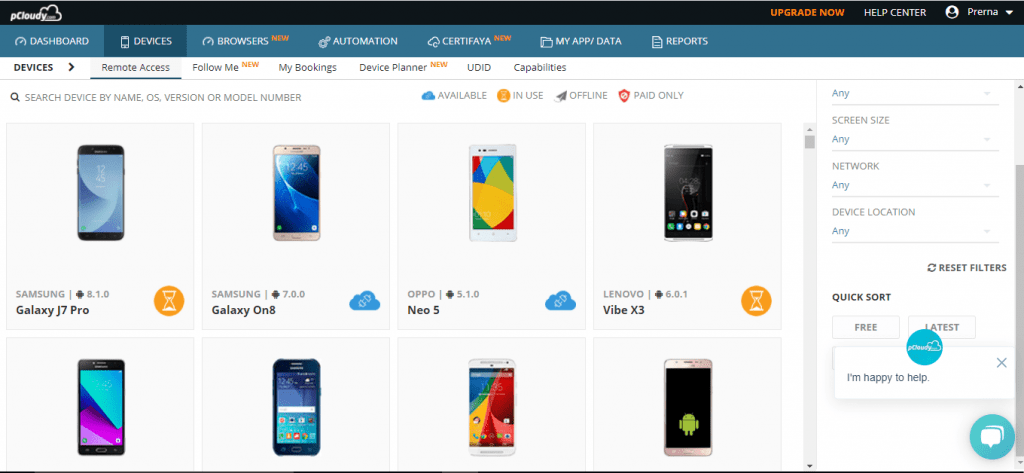Top 8 Strategies for Successful Cross Browser Testing
We live in an age where more than 5 lakh websites are created daily. As of today there are nearly 4 million websites in the world out of which only 1.5 million are active. What about the rest? As per records 90% of the web applications fail to work because of browser compatibility issues and 62% of mobile application uninstalls happen due to mobile crashes like poor responsiveness and alignment issues indirectly aiming at improper cross browser testing. These sobering statistics speak volumes on how crucial cross browser testing is for developing a fully working web or mobile application. QA’s and developers from different organisations do make regular efforts to keep cross browser testing up to the mark but defining a strategy would help in avoiding the bottlenecks that hinder your application’s timely release. It is a high time that we re-evaluate our tools and methods around cross browser testing and hunt for better alternatives to fit in. So let’s discuss the top notch strategies which would make cross browser testing simpler, faster, qualitative and convenient.
Choose the right set of devices and browsers

Choosing the right combination of browsers and devices for cross browser testing is nothing less of a giant leap covering a major milestone in the ongoing process. Using your product’s usage data to determine which devices and browsers your customers prefer is a key component to start the process. Once you have calculated and analysed the types of devices and browsers your customers prefer, you will need to revise the list to meet the changing browsers and devices in the target market. Once the list of prioritized and must have browsers and devices is made, you will need to make sure that you check and take actions when older devices and browsers disappear and the newer ones appear.
Replace all the emulators with the real devices to get the accurate result.
Choose the best UI Test Frameworks
Choosing a good UI testing framework is the next pillar once you have set the foundation of selecting the right devices and updated set of browsers and devices. A good UI testing framework can make the entire browser testing simple and seamless to develop high performance applications.
It’s always recommended to select a framework by analysing and understanding your product’s and team’s needs.
UI Test framework for Web Applications
The most popular, reliable and robust UI testing framework for testing web applications is Selenium. It’s not only one of the easiest web UI testing frameworks to learn, but also once adapted by the QA and development team, it avoids a lot of unexpected loopholes that we might face in the future. Selenium webdriver is used for automating cross browser testing. Selenium Webdriver accepts commands and sends them to the browser to execute. Testing teams use selenium webdriver to automate tests for their web applications by instructing the webdriver to perform specific actions in the browser and the device. Selenium helps your team to save a lot of valuable time which will enable them to focus on other tasks that require their full attention such as analysing the test reports and performing manual testing. Before starting automation in Selenium you should analyse which test cases can and cannot be automated in Selenium.
UI Test frameworks for Mobile Applications
The most popular test automation frameworks with their pros and cons for mobile application testing are as follows:
Appium : Appium is the most popular open source test automation framework which can test all kinds of mobile applications like hybrid, web and native. You can perform testing of mobile applications for both android and iOS devices. It uses the same library functions of selenium, making it easy to use and adopt . It runs the test cases using the WebDriver interface. Since it supports multiple platforms, testers can also reuse their source code for testing on iOS and Android. With Appium you might encounter slower test processing and flakiness than other frameworks.
Espresso: Espresso is another open source test automation tool for Android applications developed by google. It enables the developers and testers to write reliable tests for Android UI. Hence, Espresso performs better as the tests are faster and less flaky as compared to Appium. Espresso test automation uses high end technological practices like continuous testing, agile development and Devops.
Make use of Automation and Parallel Testing
For cross browser testing, automating Selenium tests is a must for improving test execution time. However, along with that executing parallel testing is what makes cross browser testing complete and productive. For example, If you were to test a combination of 10 different browsers and devices through a test case which takes 10 mins to execute, it will close it 100 minutes to execute, but with parallel testing it will take only 10 minutes for the entire task . Hence, parallel testing allows to perform testing for multiple browsers and devices in the shortest time while selenium grid for test automation allows to run test cases in several environments at once. The combination of the two aspects to testing would drive cross browser testing at an optimum level. You can streamline this flow further through a CI/CD pipeline using continuous integration, wherein test cycles are executed much earlier and often due to frequent commits made in a centralised repository.
The benefits of testing on Cloud over On-premise testing
Setting up a physical device lab requires a lot of time, money and effort. However, it guarantees a high level security as well. On the other hand, you have a number of online platforms specially the SaaS products, consisting of a cloud-based setup which can be accessed from anywhere, anytime. Cloud platforms eliminate the heavy cost, time investments, space and also the manpower needed to maintain the physical infrastructure. An added advantage is the ease of access by which geographically separated teams can collaborate, the 24/7 access time along with flexible working hours keeps business continuity intact which is a huge benefit to the company .The only downside with “some” SaaS products is that they fail to provide the modern security requirements. On the other hand there are some companies that provide on-premise services wherein the device lab is provided inside the infrastructure of the company and the maintenance control is also available to the respective client. However, this SaaS product provides out of the box features but doesn’t facilitate enough customization functions to suit each brand’s requirements.
So an ideal and need of the hour SaaS product would be the one which is equipped with the following functionalities:
- Extremely customizable to suit an organisation’s dynamic requirements
- Support multiple frameworks
- Allows to run test cases on multiple environments
- Allows to run parallel test cases and is highly scalable
- Supports futuristic technologies like AI and machine learning
- Supports high-end technologies like continuous testing, continuous integration, agile development and DevOps
- Consists of high number of device browser combinations to facilitate cross browser compatibility with all the devices available in the target market
- Is security complaint to your business
Choose a testing platform which is highly scalable
Cross browser compatibility can be achieved only when dynamic market requirements are addressed and this can be achieved by having a device lab which can easily add and remove the devices as per project requirements. The combination of browsers and their versions, OS and their versions, devices and their versions is highly uncertain. Hence your device lab should be highly scalable so that the devices can be added or removed as per the project requirements without affecting the other functionalities of the device lab.
Be Flexible and Allow Customization
Surviving a highly dynamic market like the application industry requires a platform which is always service-ready, meaning that it should have such hardware and software integrations flexible enough to allow customizations at any given point of time. Application industry is a market directly exposed to the user base whose demands keep changing. So make sure that your product is flexible enough to adapt the future requirements of the customers and capable of delivering quality products on time!
Make use of AI-powered testing tools
No matter how much you try, you cannot remove errors or bugs from a software application. However, you can definitely dilute its concentration to achieve high quality results. Efforts are being made from almost all the SaaS product organizations to use high-end technologies like continuous integration and DevOps to achieve quicker and qualitative results. But AI can help to accelerate the process even further by providing codeless solutions .This will reduce the time and effort of the QA teams to a great extent. Also, AI and machine learning can be utilised to decrease the flakiness of test cases, so that regular efforts can be made to achieve automation and no human intervention features supported by AI.
Meet the security requirements of the business
Today the mobile and software application industry has covered almost all verticals under its umbrella. Organizations aligned to banking and insurance domains using applications are highly vulnerable to security breaches and malpractices that happen across the internet. Hence, making sure that you are using a product which provides all your security requirements and is a certified security complaint product is crucial for smooth successful business functioning.
Conclusion
Cross browser testing is very crucial for developing high performance applications, but at the same time it is a very complicated test suite as it has to deal with multiple combinations of browsers, operating systems and devices. But proper planning and strategies can make the process much simpler, faster, and qualitative. Planning for cross browser testing starts with re-evaluating your list of browsers, OS, devices etc and repeating the drill for regular intervals. So if you haven’t started this process yet then it’s a high time to plan the actionables. pCloudy is a SaaS product for mobile and web application testing which is equipped with more than 2000+ device browser combinations making it strong for compatibility testing with a wide variety of devices available in the target market. It has two independent platforms for mobile application testing and desktop application testing with a variety of out of the box user friendly features. pCloudy being a cloud platform, it is highly conducive for seamless parallel testing, highly scalable and equipped with high-end techniques like agile development and continuous integration that act as a catalyst in delivering faster and high quality results for cross browser testing.
Published on Java Code Geeks with permission by Balamurugan, partner at our JCG program. See the original article here: Top 8 Strategies for Successful Cross Browser Testing Opinions expressed by Java Code Geeks contributors are their own. |


